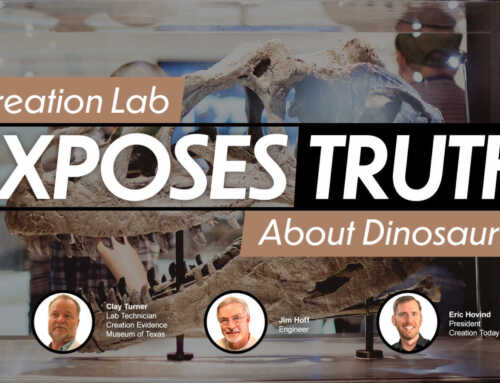Whenever the worldview of evolution is questioned, the topic of carbon dating always comes up. Here is how carbon dating works and the assumptions it is based upon.
How Carbon Dating Works
Radiation from the sun strikes the atmosphere of the earth all day long. This energy converts about 21 pounds of nitrogen into radioactive carbon 14. This radioactive carbon 14 slowly decays back into normal, stable nitrogen. Extensive laboratory testing has shown that about half of the C-14 molecules will decay in 5,730 years. This is called the half-life. After another 5,730 years half of the remaining C-14 will decay leaving only 1⁄4 of the original C-14. It goes from 1⁄2 to 1⁄4 to 1⁄8, etc. In theory it would never totally disappear, but after about 5 half-lives the difference is not measurable with any degree of accuracy. This is why most people say carbon dating is only good for objects less than 40,000 years old. Nothing on earth carbon dates in the millions of years, because the scope of carbon dating only extends a few thousand years. Willard Libby invented the carbon dating technique in the early 1950s. The amount of carbon 14 in the atmosphere today is about .0000765%. It is assumed there would be the same amount found in living plants or animals since the plants breath CO₂ and animals eat the plants.
Since sunlight causes the formation of C-14 in the atmosphere, and normal radioactive decay takes it out, there must be a point where the formation rate and the decay rate equalizes. This is called the point of equilibrium. To illustrate: If you were trying to fill a barrel with water but there were holes drilled up the side of the barrel, as you filled the barrel it would begin leaking out the holes. At some point you would be putting it in and it would be leaking out at the same rate. You will not be able to fill the barrel past this point of equilibrium. In the same way the C-14 is being formed and decaying simultaneously. A freshly created earth would require about 30,000 years for the amount of C-14 in the atmosphere to reach this point of equilibrium because it would leak out as it is being filled. Tests indicate that the earth has still not reached equilibrium. There is more C-14 in the atmosphere now than there was 40 years ago. This would prove the earth is not yet 30,000 years old! This also means that plants and animals that lived in the past had less C-14 in them than do plants and animals today. Just this one fact totally upsets data obtained by C-14 dating.
The carbon in the atmosphere normally combines with oxygen to make carbon dioxide (CO₂). Plants breathe CO₂ and make it part of their tissue. Animals eat the plants and make it part of their tissues. A very small percentage of the carbon plants take in is radioactive C-14. When a plant or animal dies, it stops taking in air and food so it should not be able to get any new C-14. The C-14 in the plant or animal will begin to decay back to normal nitrogen. The older an object is, the less carbon 14 it contains. One gram of carbon from living plant material causes a Geiger counter to click 16 times per minute as the C-14 decays. A sample that causes 8 clicks per minute would be 5,730 years old (the sample has gone through one half-life) and so on.
The Assumptions of Carbon Dating
Although this technique looks good at first, carbon-14 dating rests on at least two simple assumptions. These are, obviously, the assumption that the amount of carbon 14 in the atmosphere has always been constant and that its rate of decay has always been constant. Neither of these assumptions is provable or reasonable. An illustration may help: Imagine you found a candle burning in a room, and you wanted to determine how long it was burning before you found it. You could measure the present height of the candle (say, 7 inches) and the rate of burn (say, an inch per hour). In order to find the length of time since the candle was lit, we would be forced to make some assumptions. We would, obviously, have to assume that the candle has always burned at the same rate, and assume an initial height of the candle. The answer changes based on the assumptions. Similarly, scientists do not know that the carbon-14 decay rate has been constant. They do not know that the amount of carbon 14 in the atmosphere is constant. Present testing shows the amount of C-14 in the atmosphere has been increasing since it was first measured in the 1950s. This may be tied in to the declining strength of the magnetic field.
In addition to the above assumptions, dating methods are all subject to the geologic column date to verify their accuracy. If a date obtained by radiometric dating does not match the assumed age from the geologic column, the radiometric date will be rejected. The so-called geologic column was developed in the early 1800s over a century before there were any radio- metric dating methods. “Apart from very ‘modern’ examples, which are really archaeology, I can think of no cases of radioactive decay being used to date fossils.”1 Laboratories will not carbon date dinosaur bones (even frozen ones which could easily be carbon dated) because dinosaurs are supposed to have lived 70 million years ago according to the fictitious geologic column. An object’s supposed place on the geologic column determines the method used to date it. There are about 7 or 8 radioactive elements that are used today to try to date objects. Each one has a different half-life and a different range of ages it is supposed to be used for. No dating method cited by evolutionists is unbiased.2
The Wild Dates of Carbon Dating
A few examples of wild dates by radiometric dating:
- Shells from living snails were carbon dated as being 27,000 years old. 3
- Living mollusk shells were dated up to 2,300 years old. 4
- A freshly killed seal was carbon dated as having died 1,300 years ago. 5
- “One part of the Vollosovitch mammoth carbon dated at 29,500 years and another part at 44,000.” 6
- “Structure, metamorphism, sedimentary reworking, and other complications have to be considered. Radiometric dating would not have been feasible if the geologic column had not been erected first.”7
- Material from layers where dinosaurs are found carbon dated at 34,000 years old.8
2 Peter 3:15 Yourself with these Resources
Thousands…Not Billions eBook by Dr. Don DeYoung
Evolution Handbook by Vance Ferrell
- Ager, Derek V., “Fossil Frustrations,” New Scientist, vol. 100 (November 10, 1983), p. 425) ↩
- (Bones of Contention by Marvin Lubenow; Scientific Creationism by Henry Morris) ↩
- Science vol. 224, 1984, pp. ,code>58-61 ↩
- Science vol. 141, 1963, pp.
634-637↩ - Antarctic Journal vol. 6, Sept-Oct. 1971, p. 211 ↩
- Troy L. Pewe, “Quaternary Stratigraphic Nomenclature in Uniglaciated Central Alaska,” Geologic Survey Professional Paper 862 (U.S. Gov. Printing Office, 1975) p. 30 ↩
- J. E. O’Rourke, “Pragmatism vs. Materialism in Stratigraphy,” American Journal of Science, vol. 276 (January,1976), p. 54 ↩
- Reginald Daly, Earth’s Most Challenging Mysteries, 1972, p. 280 ↩




